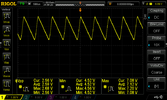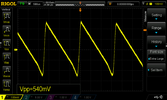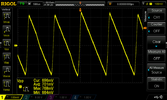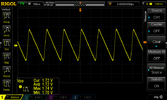So, not an owner of a Viofo cam myself, have been going through nightmares trying to install one with my father.
First - this is not a 129 issue, this is a HK3 hard wire kit issue.
Posting here as the related camera is an A129 Pro Duo
First install resulted in a camera that functioned for 20-40 seconds and then froze.
Powering it from a USB power bank, or any other Automotive 12v - 5v USB adapter worked fine, so we blamed the hard wire kit.
We receive a 2nd hard wire kit, dad installs it and similar issues.
An it's no wonder....
Have a look at the output of these things...

On average 2.59Vpp and voltage swings from 4.52 to 7.12
On what is supposed to be a regulated 5 output!
Test setup...
Rigol DP832 power supply - Ch1 13.8v simulating battery - Ch2 13.8v simulating acc - Ch1 & Ch2 grounds tied.
Rigol DS1054Z Oscilloscope measuring USB V output at the PCB
Ruideng HD35 DC load configured for 1Amp (also tested at 500mA, 100mA and 50mA with similar results) to simulate dash cam.
So we have 2 HK3 kits that do this so far.
They both power a Navman dash cam OK in this state, this was before we'd tested, had we known the output was this ugly we wouldn't have plugged the supply into anything we valued.
This could be common, or a bad few units.
Given it works intermittently and works with dashcams with lower power requirements there is a fair chance this might be happening to units that otherwise appear to be working, possibly killing them over time or rendering them unreliable.
For anyone not deeply knowledgeable we normally measure power supply ripple in millivolts (0.001v) not full volts.
That's how bad these are.
So 2 for 2 so far.
Will take this up with Viofo and the seller.
Possible bad batch, but I'm concerned this might be wider spread.
There is no easy way to do it but if you have the facilities to test your own HK3 kit output I'd suggest you do so, but i suspect few would have the right gear.
I'm open to doing testing for people, but im in Melbourne, Australia so could be logistically difficult.
Edit re low voltage cutout
Forgot to mention, tested the low voltage disconnect on the bench, notes are poor as it was not the primary reason i was at the bench.
Testing 11.8V low voltage showed the device to disconnect at 11.0v
Testing again at 12.4V the device disconnected at approx 11.4v
Did not test 12.0 nor 12.2v disconnect.
end edit
I'll post a follow up as i learn more.
First - this is not a 129 issue, this is a HK3 hard wire kit issue.
Posting here as the related camera is an A129 Pro Duo
First install resulted in a camera that functioned for 20-40 seconds and then froze.
Powering it from a USB power bank, or any other Automotive 12v - 5v USB adapter worked fine, so we blamed the hard wire kit.
We receive a 2nd hard wire kit, dad installs it and similar issues.
An it's no wonder....
Have a look at the output of these things...

On average 2.59Vpp and voltage swings from 4.52 to 7.12
On what is supposed to be a regulated 5 output!
Test setup...
Rigol DP832 power supply - Ch1 13.8v simulating battery - Ch2 13.8v simulating acc - Ch1 & Ch2 grounds tied.
Rigol DS1054Z Oscilloscope measuring USB V output at the PCB
Ruideng HD35 DC load configured for 1Amp (also tested at 500mA, 100mA and 50mA with similar results) to simulate dash cam.
So we have 2 HK3 kits that do this so far.
They both power a Navman dash cam OK in this state, this was before we'd tested, had we known the output was this ugly we wouldn't have plugged the supply into anything we valued.
This could be common, or a bad few units.
Given it works intermittently and works with dashcams with lower power requirements there is a fair chance this might be happening to units that otherwise appear to be working, possibly killing them over time or rendering them unreliable.
For anyone not deeply knowledgeable we normally measure power supply ripple in millivolts (0.001v) not full volts.
That's how bad these are.
So 2 for 2 so far.
Will take this up with Viofo and the seller.
Possible bad batch, but I'm concerned this might be wider spread.
There is no easy way to do it but if you have the facilities to test your own HK3 kit output I'd suggest you do so, but i suspect few would have the right gear.
I'm open to doing testing for people, but im in Melbourne, Australia so could be logistically difficult.
Edit re low voltage cutout
Forgot to mention, tested the low voltage disconnect on the bench, notes are poor as it was not the primary reason i was at the bench.
Testing 11.8V low voltage showed the device to disconnect at 11.0v
Testing again at 12.4V the device disconnected at approx 11.4v
Did not test 12.0 nor 12.2v disconnect.
end edit
I'll post a follow up as i learn more.
Last edited:




